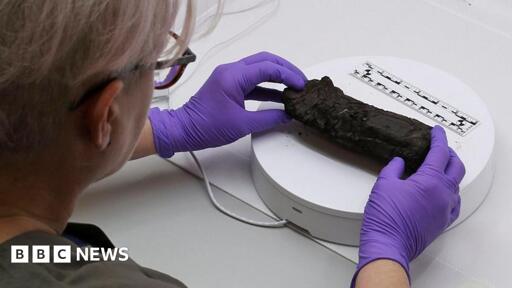- cross-posted to:
- hackernews@lemmy.bestiver.se
- science@lemmy.world
- cross-posted to:
- hackernews@lemmy.bestiver.se
- science@lemmy.world
It’s a 10m papyrus scroll from Herculaneum, one of the cities buried by Vesuvius’ volcanic ash in 79 CE. It’s fully carbonised but they’re using a synchrotron to create a 3D model of the scroll without damaging it. Then they’re using AI (pattern recognition AI, perhaps?) to detect signs of ink, so they can reconstruct the text itself.
The project lead Stephen Parson claims that they’re confident that they “will be able to read pretty much the whole scroll in its entirety”. And so far it seems to be a work of philosophy.
This is one of the best applications of AI thus far, in my opinion, and I can’t wait to read more about what they uncover.
I hold out hope against hope that something similar will one day be possible with the rotted lumps of Maya codices, but I’m not exactly holding my breath.
I agree, this sort of AI pattern detection works really well: it is not a big deal if the AI misidentifies a few strokes of ink, but it is a big deal how fast it’s able to process the whole thing. And it’s likely trained locally, for a specific task so no unreasonably high usage of electricity. It has almost all the pros but none of the cons!
I hold out hope against hope that something similar will one day be possible with the rotted lumps of Maya codices, but I’m not exactly holding my breath.
I hope so, but just like you I’m not holding my breath. Biological activity is messier; the surviving ones are likely full of holes.
To complicate things further, most of the works are already gone. A good chunk because of the Aztecs going full 1984 and destroying stuff to control the subjugated Maya peoples; then the Spaniards mixing disdain and hostility towards the local cultures, plus “plebs don’t need to read, the only thing to read is the Bible, and unless you’re a priest you’ll read it wrong”.
My position has always been that AI is useful given these conditions:
- Both the input and output of the AI are defined and limited in scope (ie, designed to serve a specific purpose rather than be multi-purpose)
- It is difficult or impossible to come up with an algorithm that can do the same thing (ie, too many variables to be easily analyzed)
- How the output is derived is unimportant or less important than the final output itself
This is a genuinely good application of AI:
- The AI is designed to identify and read text in scrolls
- The combination of low signal in the scan and requirement for image recognition capabilities makes AI perhaps the only feasible solution for the problem
- We care about the text itself, not why we think the text is what it is
This is what bothers me so much about the vocally anti-ai people. Like, yes, OpenAI is another grift and the tech bros are trying (and succeeding) at bending the tech to serve their profits. However, the underlying tech is fucking cool and has lots of potential applications.
We shouldn’t stop researching neural nets just because like 5 assholes want to abuse it; we should just regulate the space and outlaw that kind of abuse of power.
Just assume the “vocally anti ai” people are actually anti openai etc.
I wouldn’t be so eager to assume so - the vocally anti-AI people resemble a lot the “AGI is coming!” crowds:
- neither analyses rationally the [merits | demerits] of the technology
- both assume applications to be [bad | good] solely on their usage of AI, with no regards to why and how
- both flip from decent reading proficiency to “I dun unrurrstand, I is so confusion…” mode once someone voices an argument they can’t handle
- both assume that, if you say something that might be superficially understood as against their view, you must be among in the other group thus you must be a shitty person
And they’ll do it even if you casually mention to be running locally some LLM or diffusion model, with no ties to the GAFAM + “Open”“A”“I” slop.




